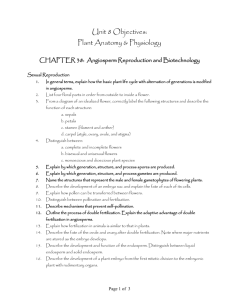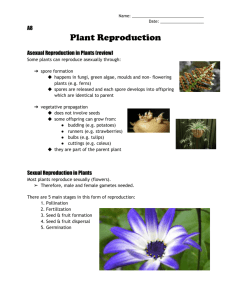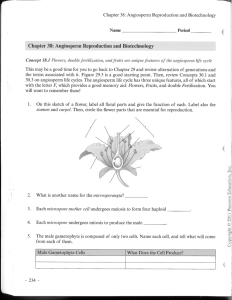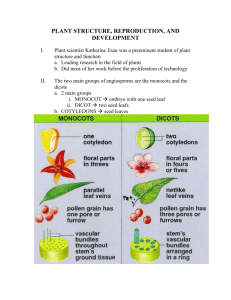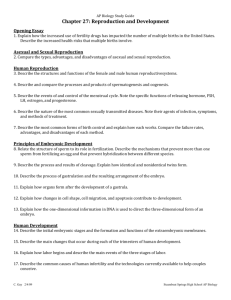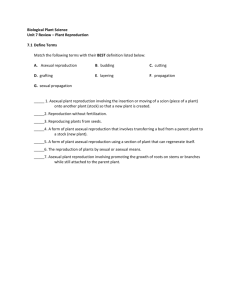chapter 38 - mr-youssef-mci
advertisement
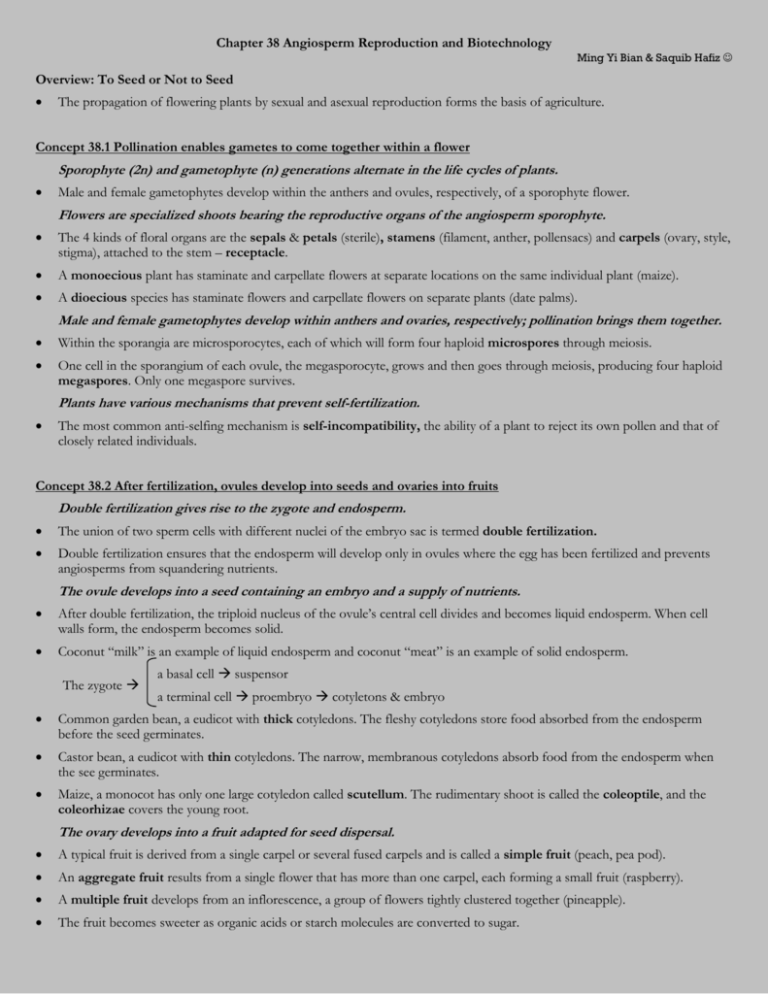
Chapter 38 Angiosperm Reproduction and Biotechnology Ming Yi Bian & Saquib Hafiz Overview: To Seed or Not to Seed The propagation of flowering plants by sexual and asexual reproduction forms the basis of agriculture. Concept 38.1 Pollination enables gametes to come together within a flower Sporophyte (2n) and gametophyte (n) generations alternate in the life cycles of plants. Male and female gametophytes develop within the anthers and ovules, respectively, of a sporophyte flower. Flowers are specialized shoots bearing the reproductive organs of the angiosperm sporophyte. The 4 kinds of floral organs are the sepals & petals (sterile), stamens (filament, anther, pollensacs) and carpels (ovary, style, stigma), attached to the stem – receptacle. A monoecious plant has staminate and carpellate flowers at separate locations on the same individual plant (maize). A dioecious species has staminate flowers and carpellate flowers on separate plants (date palms). Male and female gametophytes develop within anthers and ovaries, respectively; pollination brings them together. Within the sporangia are microsporocytes, each of which will form four haploid microspores through meiosis. One cell in the sporangium of each ovule, the megasporocyte, grows and then goes through meiosis, producing four haploid megaspores. Only one megaspore survives. Plants have various mechanisms that prevent self-fertilization. The most common anti-selfing mechanism is self-incompatibility, the ability of a plant to reject its own pollen and that of closely related individuals. Concept 38.2 After fertilization, ovules develop into seeds and ovaries into fruits Double fertilization gives rise to the zygote and endosperm. The union of two sperm cells with different nuclei of the embryo sac is termed double fertilization. Double fertilization ensures that the endosperm will develop only in ovules where the egg has been fertilized and prevents angiosperms from squandering nutrients. The ovule develops into a seed containing an embryo and a supply of nutrients. After double fertilization, the triploid nucleus of the ovule’s central cell divides and becomes liquid endosperm. When cell walls form, the endosperm becomes solid. Coconut “milk” is an example of liquid endosperm and coconut “meat” is an example of solid endosperm. The zygote a basal cell suspensor a terminal cell proembryo cotyletons & embryo Common garden bean, a eudicot with thick cotyledons. The fleshy cotyledons store food absorbed from the endosperm before the seed germinates. Castor bean, a eudicot with thin cotyledons. The narrow, membranous cotyledons absorb food from the endosperm when the see germinates. Maize, a monocot has only one large cotyledon called scutellum. The rudimentary shoot is called the coleoptile, and the coleorhizae covers the young root. The ovary develops into a fruit adapted for seed dispersal. A typical fruit is derived from a single carpel or several fused carpels and is called a simple fruit (peach, pea pod). An aggregate fruit results from a single flower that has more than one carpel, each forming a small fruit (raspberry). A multiple fruit develops from an inflorescence, a group of flowers tightly clustered together (pineapple). The fruit becomes sweeter as organic acids or starch molecules are converted to sugar. Evolutionary adaptations of seed germination contribute to seedling survival. As a seed matures, it dehydrates and enters a dormancy phase (to sleep). Germination of seeds depends on imbibition, the uptake of water due to the low water potential of the dry seed. The first organ to emerge from the germinating seed is the radicle, the embryonic root. The advantage of seed dormancy is to prevent the premature germination of seeds. A seed will germinate only when the environmental conditions are optimal for the survival of its embryo as a young seedling. Concept 38.3 Many flowering plants clone themselves by asexual reproduction Many plants clone themselves by asexual reproduction. If a plant is superbly suited to a stable environment, asexual reproduction (all of its genes are passed on) has advantages: reproduce more rapidly, suited in stable environment, and the offspring are not as frail as the seedlings. In unstable environments, where evolving pathogens and other variables affect survival and reproductive success, sexual reproduction (only half of its genes passed on) can be advantageous because it generates variation in offspring. Asexual reproduction is an extension of the capacity of plants for indeterminate growth. There are different methods of asexual reproduction, including fragmentation, apomixes, cutting and grafting. Plant biotechnologists have adopted in vitro methods to create and clone novel plant varieties. Once roots and shoots have developed, the test-tube plantlets can be transferred to soil, where they continue their growth. Plant tissue culture facilitates genetic engineering of plants. Transgenic plants are genetically modified (GM) plants. Another approach combines protoplast fusion with tissue culture methods to invent new plant varieties that can be cloned. Concept 38.4 Plant biotechnology is transforming agriculture Plant biotechnology has two meanings. One is innovation in the use of plants, or of substances obtained from plants, to make products of use to humans. Biotechnology refers to the use of genetically modified (GM) organisms in agriculture and industry. Neolithic humans created new plant varieties by artificial selection. Humans have intervened in the reproduction and genetic makeup of plants for thousands of years. Selective breeding by humans has created plants that could not survive or reproduce in the wild. Maize is a staple in many developing countries. However, the beneficial trait was closely associated with several undesirable ones. Plant breeders created maize varieties that had higher nutritional value without the undesirable traits. Unlike traditional plant breeders, modern plant biotechnologists, using the techniques of genetic engineering, are not limited to transferring genes between closely related species or varieties of the same species, but distantly related plant species. The commercial adoption by farmers of transgenic crops has been one of the most rapid cases of technology transfer in the history of agriculture. These crops include cotton, maize, and potatoes that contain genes from a bacterium Bacillus thuringiensis. Plant biotechnology has incited much public debate. One specific concern is that genetic engineering could potentially transfer allergens, molecules to which some humans are allergic, from a gene source to a plant used for food. Probably the most serious concern that some scientists raise is the possibility that introduced genes may escape from a transgenic crop into related weeds through crop-to-weed hybridization. “Terminator technology” may offer another approach to the problem of transgene escape.
